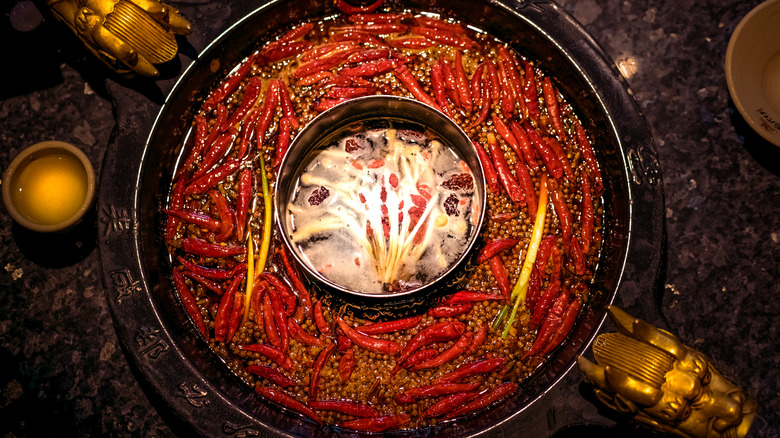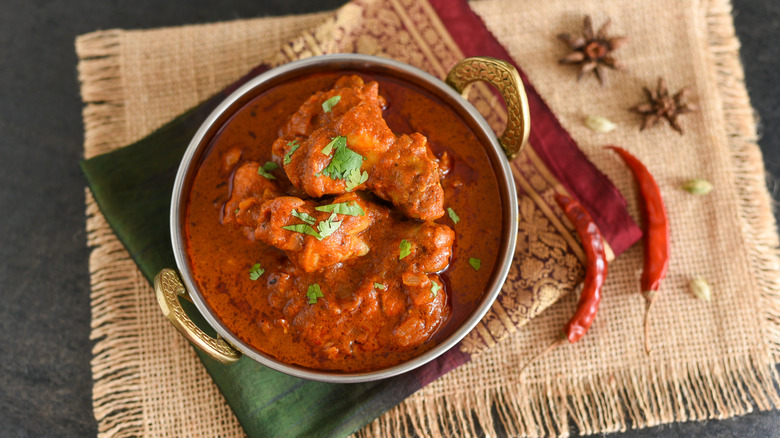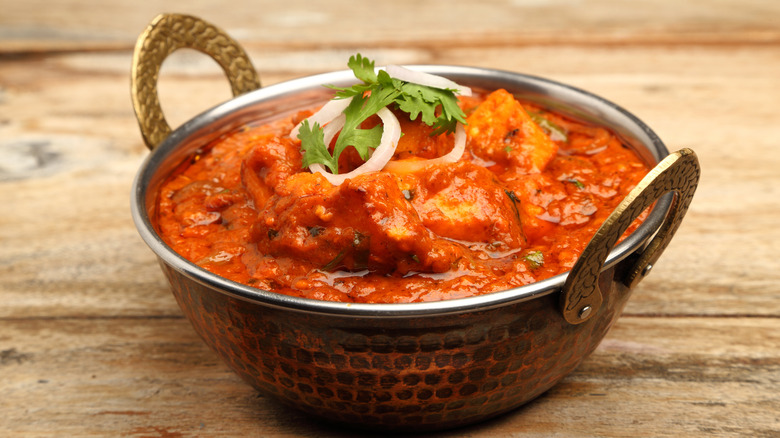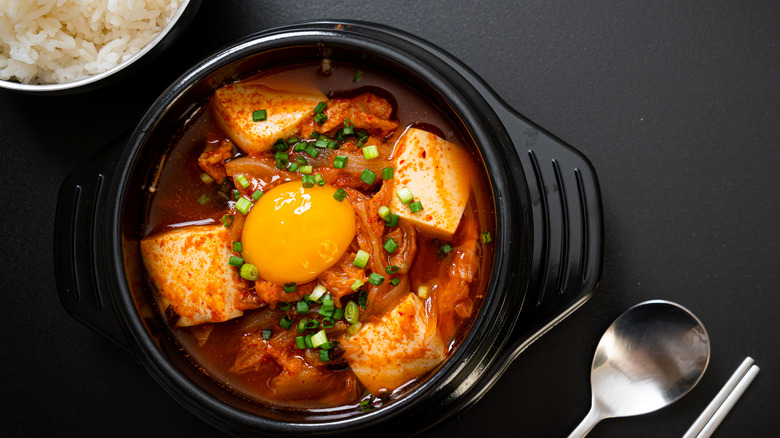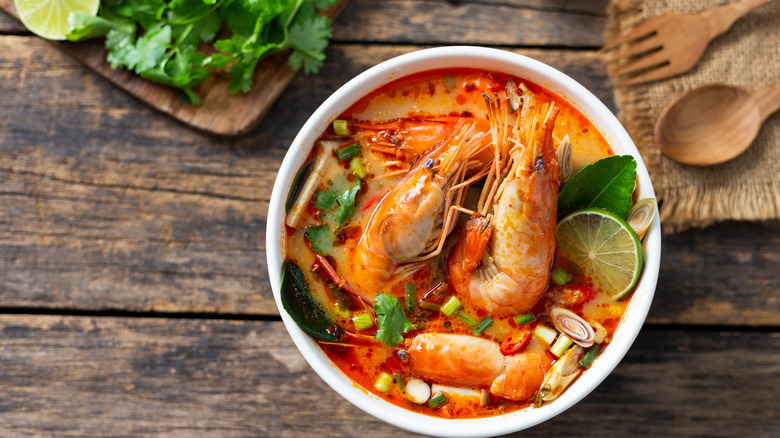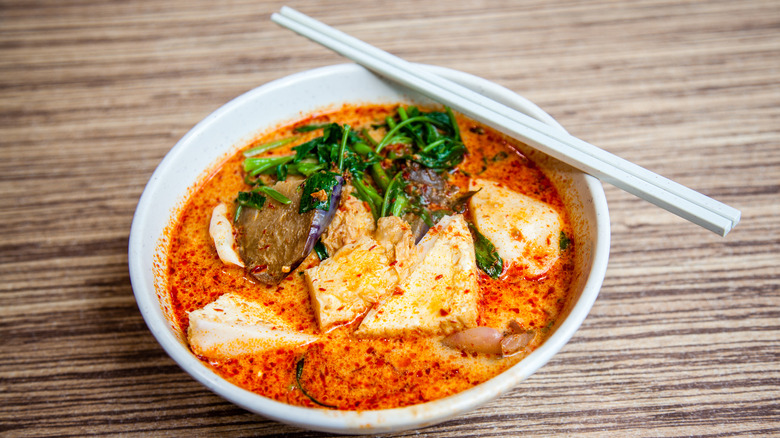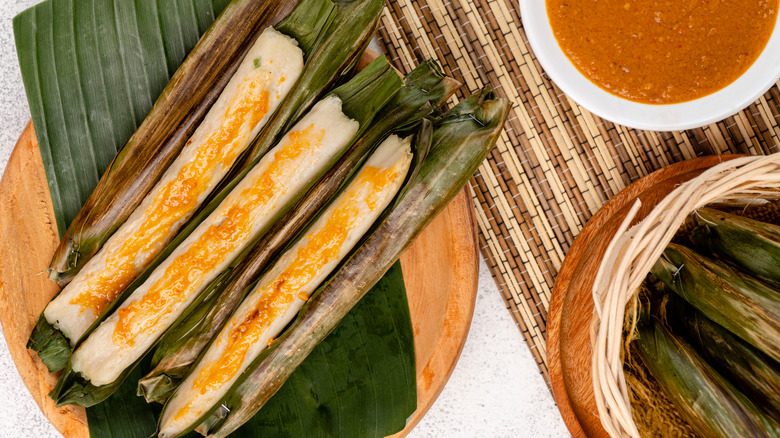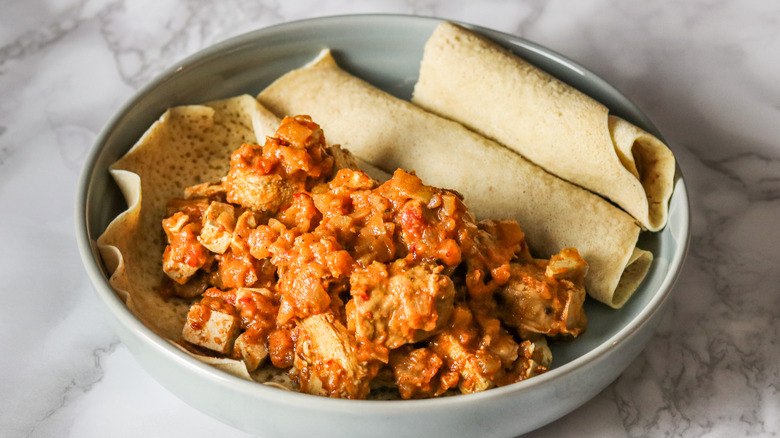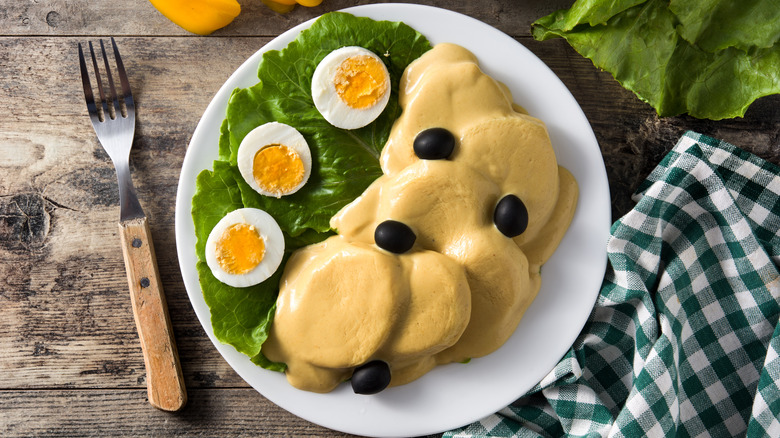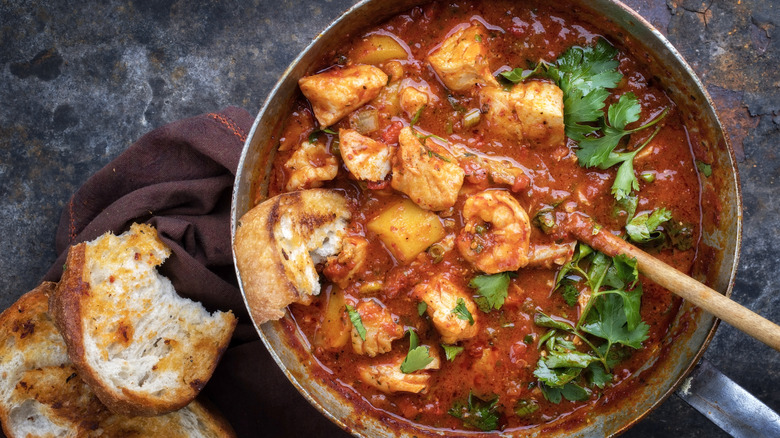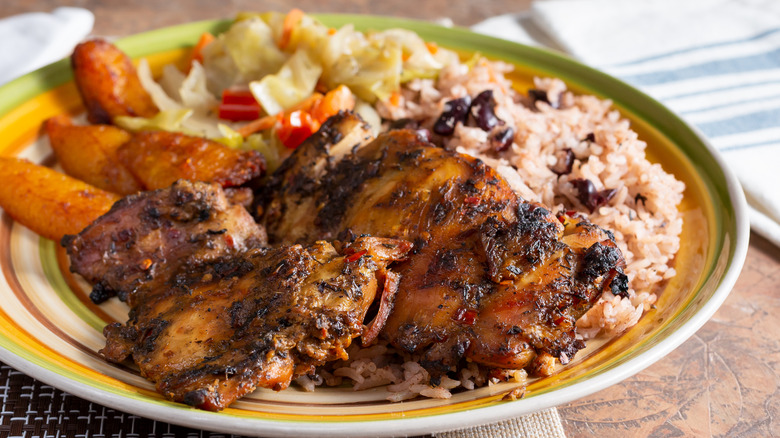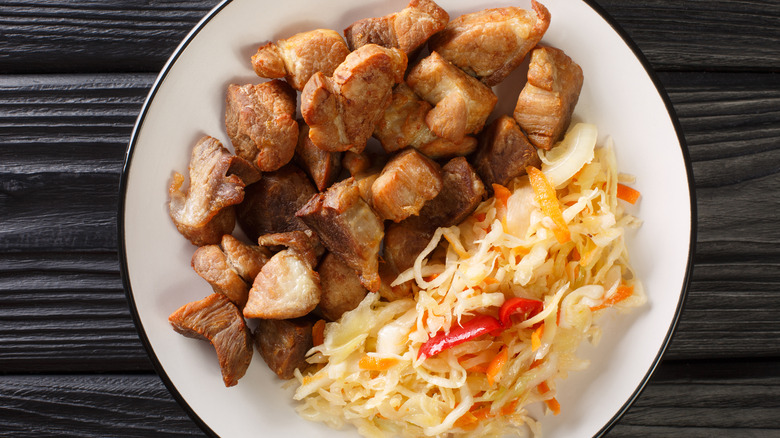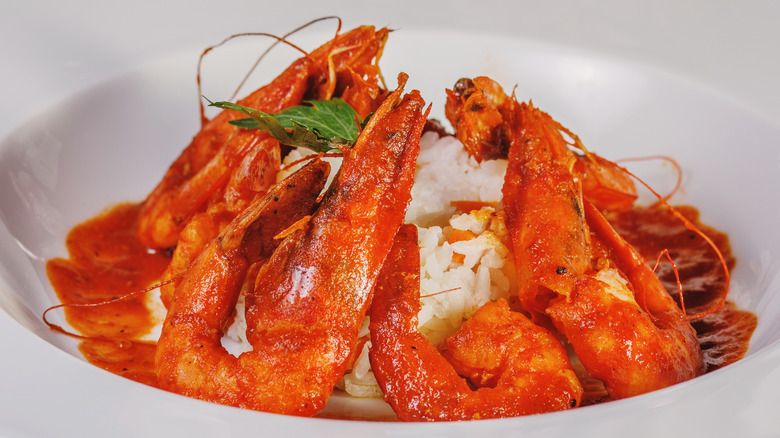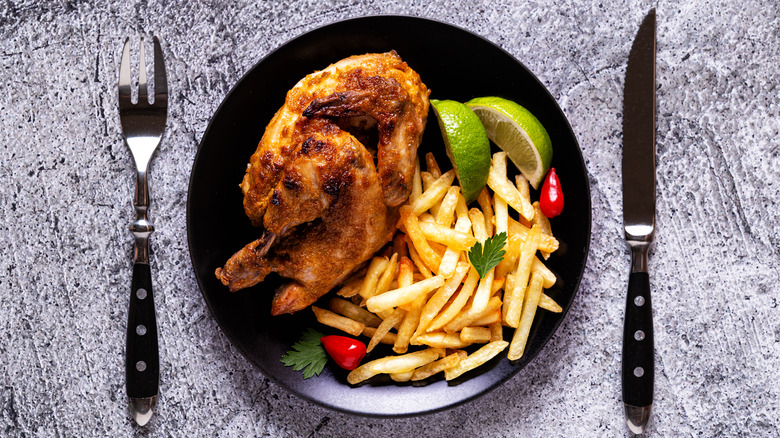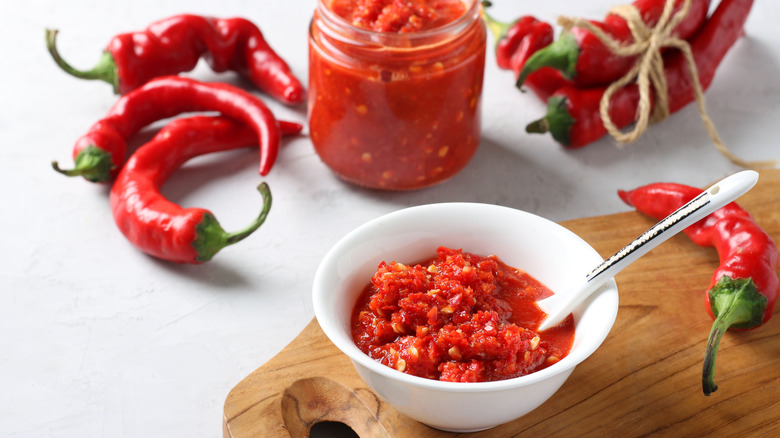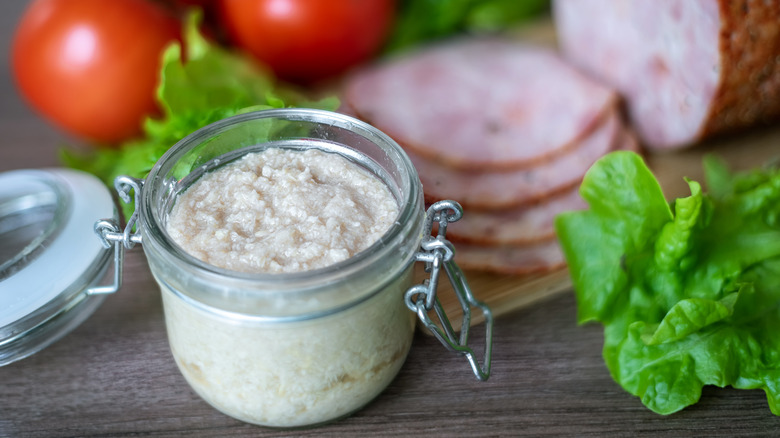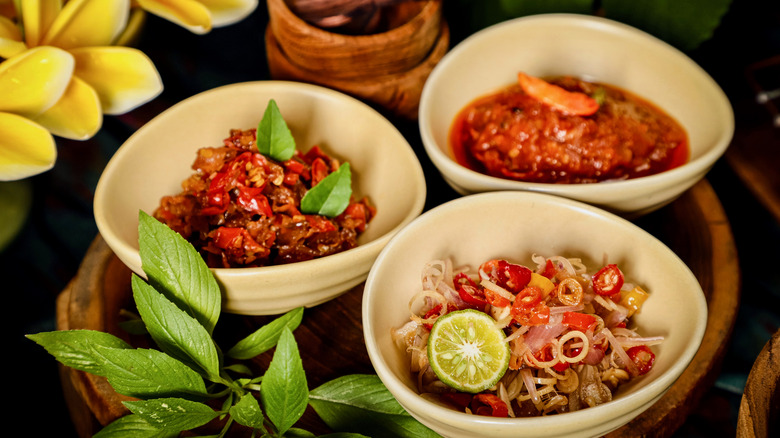Spicy Foods You Need To Try Before You Die
Once you develop a taste for spicy food, it's easy to become tempted by increasingly hot options. Sure you can prepare a lot of classic meals with the addition of a few chili peppers, but there are many dishes that are expressly made to pique your spice sensors. Various cultures specialize in cuisines centered around intense flavors, including an extra fiery kick. Most dishes featured rely on local chili peppers that find their way into many traditional recipes. Although most chilis originate from the Americas, the peppers were introduced across the world by Portuguese and Spanish explorers (via Nautilus).
While eating spicy food can sometimes approach a competitive sport, it is also inherent to many of the world's cuisines. If you have an appetite for spice, you'll want to read on for a list of foods you have to try before you die. Of course, if you can eat them at the source then do so, however many dishes can be approximated from the comfort of your own kitchen. You might miss out on some of the rarer deadly chili peppers, but you'll no doubt be able to enjoy some amazing flavors while pushing the boundaries of heat.
Sichuan Hot Pot
Chinese Sichuan food is among the spicier offerings in the large country. Thanks to the Sichuan peppercorn, any dish that includes the spicy chili takes on a numbing quality that will fill your mouth with a buzzing sensation. Depending on how the chili is incorporated into a recipe, the spice factor can vary from slightly noticeable to intense and overwhelming. Hot pot dishes don't necessarily have to include the peppercorn itself, but the traditional Sichuan rendition does, according to Taste Atlas.
The source describes the dish as a pot of hot broth used to cook various meats, seafood, and vegetables. The broth is well-seasoned and incorporates the numbing peppercorn and extra chilis so that each bite of food that is boiled in it takes on the zingy flavor (via Food52). If you've never had the chance to sit down and share a hot pot with others, gather up your spice-loving friends and give it a try. Since the actual ingredients are so versatile, the dish is perfect for vegetarians and meat-eaters alike. Food52 indicates that the dish is pretty straightforward to make at home, but for the full experience, it's worthwhile to go to a hot pot restaurant if you have one in the vicinity.
Goan Vindaloo
It's no secret that Indian cuisine contains endless examples of dishes perfect for spice lovers. Vindaloo is a curry from Goa that has gone through its fair share of culinary evolution. According to Saveur, a version of the dish was introduced in India by Portuguese explorers who also brought along the chili peppers. The source explains that although the dish was once more aromatic and fragrant, it became far spicier when it eventually found its way to England. Although milder styles are in fact more traditional to the original Goan dish, vindaloo can contain scotch bonnet, bird's eye chilis, or ghost peppers (known as Bhut jolokia in India) which start at around 850,000 Scoville units, as per PepperScale.
Aside from a stewed base sauce, vindaloo is usually made with pork, although fish, chicken, mutton, and beef are regularly substituted. As such, it's a great curry to try whipping up at home if you carry a variety of spices. Alternatively, as it's often considered to be one of the hottest Indian dishes, many restaurants try their hand at a fiery adaptation.
Phaal Curry
Considered by many to be hotter than vindaloo, phaal is another Indian curry that was invented in England, according to Chili Pepper Madness. Habaneros, scotch bonnets, and the infamous ghost pepper are some of the chilis used to fire up this dish. Taste Atlas describes that lamb or chicken are the typical meats of choice in the tomato and ginger-based curry, and of course plenty of chilis both dry and fresh to amplify the heat.
If you're looking to make a name for yourself as a spice-tolerant champion, then phaal should be on your radar. Brick Lane Curry House in New York City prepares a phaal with California reaper chilis that requires anyone attempting to eat it to sign a disclaimer confirming that they will not hold the restaurant responsible for damages. Winners who manage to finish their meal end up in their P'haal of Fame which is undoubtedly a certain kind of achievement. Considering that the chef who prepares the dish actually wears a gas mask, you might want to attempt a slightly subtler version for plenty of spice minus the sense of impending torture and doom.
Kimchi Jjigae
Korean food has its fair share of spicy dishes, and kimchi jjigae finds itself at the top. LAist describes it as volcanic red, the type of fiery color that evokes the certainty of spice. As per the Journal of Ethnic Foods, the type of chili pepper common to Korea is unrelated to those from America that were brought to Asia by the Portuguese. The Korean pepper is called gochu and has been fundamental to the cuisine for almost two millennia. It's the foundation of the fermented paste gochujang, and the dried pepper is used in many traditional preparations as well.
Kimchi jjigae is a stew made with ripe kimchi, the iconic Korean fermented cabbage, gochu, and an assortment of ingredients that are adjusted to taste (via Taste Atlas). Tofu, pork belly, seafood, and vegetables can all be added to the dish so it's just a matter of choosing what you like. Aromatic flavors are developed as ginger, scallions, and garlic stew in the flavorful broth (via LAist). Although the intensity of the heat can vary, one fact is certain — the stew is perfect if you're feeling under the weather or in need of a meal that will warm you up from the inside out.
Tom Yum Soup
The Asian continent is well known for its love of spice, and Thailand certainly shines on this front. World Atlas ranks it as number one among the world's spiciest cuisines, but thankfully there is a range of heat to choose from. Most likely, unless you're actually in Thailand, you won't have to endure excessively painful levels of spice, and instead, you'll get to enjoy a mix of intense flavors with some heat.
Tom yum soup is a mainstay of Thai menus around the world and the country's Culture Ministry recently submitted it to be included in UNESCO's global cultural heritage list, according to Bangkok Post. The soup has many renditions and generally includes lemongrass, kaffir lime leaves, galangal, and shrimp (in which case, kung — shrimp in Thai — is added to the name) (via The Phuket News). Although it wasn't always the case, the soup also contains spicy chili paste, lime, and at times coconut milk. The spice factor is balanced out by the various sweet and sour flavors but some versions can still pack in the heat. If you're tired of bland take-out options, a zesty bowl of tom yum soup is sure to hit the spot.
Laksa
Hot and spicy soups are a popular offering on the Asian continent, and laksa certainly fits the bill. The Guardian remarks that as with multiple dishes in Southeast Asia, both Malaysia and Singapore view it as their own, and renditions can be found all over. Laksa lemak aka curry laksa is probably the variation most likely to be found outside of Asia, and it's well worth a try. Coconut milk combined with a spicy paste featuring dried chilis and fermented shrimp is a common base, seasoned with garlic, lemongrass, galangal, ginger, and a blend of fragrant spices (via The Guardian). Rice, egg, or glass noodles add some starchiness to the soup and as for protein, shrimp and spongy tofu are most common. Beansprouts, snap peas, and fresh coriander are also often included to round it out.
There's no doubt about it, once you have a bowl of laksa you'll probably keep dreaming about it until the next one. For the most part, you should be able to source the ingredients required to make your own version of the dish. For extra spice, go wild with the chilis or take it back a notch by sticking with milder peppers. If you're looking for a dish that's both warm and hot to elevate your body temperature in the cooler months, laksa should be next on the menu.
Otak-Otak
Singaporean cuisine has various overlaps with neighboring Indonesian and Malaysian offerings, and otak-otak is one such dish that is served around Southeast Asia. You're probably better off not knowing that otak means brains, but Taste Atlas assures that in fact, the name comes from the appearance and not any of the actual ingredients. If you're looking for a fun culinary project or find yourself in front of a street food stand selling the dish, otak-otak is definitely worth trying.
The dish consists of a paste made from ground-up fish seasoned with ginger, shallots, scallions, coconut milk, eggs, starch to bind, chilis, lemongrass, and turmeric (via Taste Atlas). Singapore Heritage Fest indicates that kaffir lime leaves and tamarind paste are also added to balance out the dish with sweet and sour flavors. The whole is usually wrapped in banana leaf and steamed or grilled and meant to be enjoyed solo or with rice. The mild white fish makes a great contrast for the fiery kick, and you can even approximate a similar dish in your own kitchen.
Doro Wat
The African continent might not always be associated with spice, yet various countries incorporate chilis into their regional recipes. As per MasterClass, doro wat is a staple of Ethiopian cuisine — and once you try the spicy chicken stew, you'll understand why. The heat comes from a blend of spices known as berbere, which combines fenugreek, coriander, paprika, cardamom, nutmeg, garlic, and hot chilis, among other flavors. There's definitely a warm fragrant undertone to the chicken dish, and it is usually served with injera, a flatbread made from the local grain.
According to Harry Kloman who wrote a book about the country's cuisine and runs the website Ethiopian Food, locally, doro wat is a crucial recipe in every woman's repertoire if she intends to find a husband. Whether you try your hand at various renditions of the recipe with or without a love interest in mind, you're sure to be enchanted by the aromatic flavor and spicy kick that this chicken and egg stew offers. Try it at a traditional Ethiopian restaurant where various stews are dolloped onto a large piece of injera, and rolled-up strips of the flatbread take precedence over cutlery. Or, track down a blend of berbere spice and whip it up at home.
Papa a la Huancaína
Peruvian cuisine is respected across the globe and it even received the 2021 World Culinary Destination award. Thanks to the country's bounty of fresh products, you're unlikely to be bored experimenting with the local dishes. Papa a la Huancaína, named after the region Huancayo where it was created, isn't for the fainthearted, and this potato-based meal looks deceivingly bland. Boiled potatoes, a creamy yellow sauce, lettuce, hard-boiled eggs, and black olives are pretty much what you'll get (via Taste Atlas). Did we mention that the innocuous yellow sauce is actually a blend of cheese, milk, crackers, and a very spicy chili?
According to Chili Pepper Madness, the spicy yellow Peruvian chili pepper ranges from 30,000 to 50,000 Scoville units, making it more manageable than some of the deadlier options around. Nonetheless, it is a fiery dish and we can't help but imagine that the combination of cheese, potato, and spice must be delicious. If you can get your hands on the right type of chili, you can whip your own version of the dish at home. If not, a close approximation can definitely be made with your favorite chili.
Shrimp Creole
Closer to home, shrimp Creole is a dish that is common in the south of the U.S., particularly in Louisiana. According to Taste Atlas, local shrimp from the gulf are plentiful, making them ideal to simmer up in a stew. As for the base, a tomato, bell pepper, onion, and celery sauce is flavored with spices and hot chilis for an added kick. The dish is usually served with white rice which provides some balance to the heat. Creole seasoning can be fairly varied, and cayenne pepper isn't always a requirement (via PepperScale). What is however constant is the warm rich flavor provided from the complex layers of spices, including paprika, garlic, thyme, oregano, and black or white pepper.
Chili Pepper Madness points out that the preparation is super versatile and many modifications can be made depending on your spice tolerance and whatever seafood you have on hand. Choose your favorite white fish or some fresh crab and allow them to simmer in the savory sauce. You don't have to stick with white rice either — the sauce is great over your choice of pasta, or even simply with a few slices of crusty French bread to sop it up.
Jerk Chicken
Jamaican Jerk can be made with a variety of meat and entails cooking the food over an open fire after seasoning it with a regional blend of spices (via Taste Atlas). You should expect a combination of spicy and sweet flavors, complemented by the smoky undertone from the preparation. As far as the spice blend, onions, thyme, Jamaican allspice, chilis, salt, nutmeg, and cinnamon each add their own aromas.
The heat level depends on who's in charge, and while cayenne peppers offer a slightly milder take, scotch bonnets take it up a notch. Forbes remarks that the latter grows rampantly in Jamaica, so if you're trying the dish at the source then prepare for 100,000 to 350,000 Scoville units of spice. Nonetheless, it isn't just a question of overwhelming heat, and scotch bonnets have a sweet fragrant flavor that pairs seamlessly with the smoky charcoal cooking method. Chicken is a classic pairing for jerk seasoning, but choose your favorite protein and rub it with the spice blend to fire up your next barbecue.
Griot and Pikliz
Still in the Caribbean, the island of Haiti enjoys its fair share of spice forward dishes, heavily seasoned with the local chilis. Griot consists of cubed pork cooked in a marinade and then fried, Taste Atlas describes. The marinade showcases chilis, onions, and a citrus component to help tenderize the meat. The combination of sweet, sour, and spicy flavors makes this dish multilayered and helps balance out some of the heat.
According to Whetstone Magazine, the dish is often served with red beans and a local pickled relish called pikliz. The relish isn't by any means subtle and it consists of grated cabbage, carrot, onion, scallions, and garlic seasoned with vinegar, lime juice, peppercorns, and scotch bonnet peppers (via NYT Cooking). Talk about a flavor bomb! The condiment goes hand in hand with countless local dishes, but you'll love the zesty kick it provides to what might otherwise be a simple pork dish. Get your hands on pikliz at a specialty food store or try your hand at making your own. Remember — when it comes to cooking with scotch bonnets, caution is key.
Camarones a la Diabla
Spice lovers know that Mexican food has plenty to offer, and camarones a la diabla highlights this fact. Translated from Spanish, the name means deviled shrimp and pertains both to the spice and bright red color you'll get from this dish. The color comes from a tomato and chili pepper sauce used to coat giant shrimp after they've been sautéed (via MasterClass). Local chilis steal the spotlight, and both chiles de árbol and guajillo peppers are used to fire up the dish. Guajillos are on the lower end of the Scoville scale, topping around 5,000 units as per PepperScale but chiles de árbol can easily reach 30,000 units.
Of course, if you're making your own version for home, feel free to use your favorite chili peppers and further amp up the heat. The spicy shrimp are traditionally accompanied by white rice or warm tortillas, but you could serve them over your grain of choice to customize the dish. Some lime juice and coriander help to offset the heat and overall, this shrimp preparation is a great way to enjoy the seafood.
Piri-Piri Chicken
Whether you spell it piri-piri or peri-peri, the bird's eye chili-based sauce is still delicious and spicy. In fact, the name means pepper-pepper in Swahili, according to Thrillist, hinting at the level of heat you should expect. Bird's eyes are no joke, and the source places them at 150,000 Scoville units, although in the sauce they are accompanied by slightly milder peppers as well. To round out the texture, flavor, and temper some of the heat, lemon, vinegar, oil, garlic, and bay leaves are usually added in. Although the sauce is often used as a marinade for a grilled chicken dish in a quintessentially Portuguese dish, it can accompany a number of proteins, notably shrimp as seen in Mozambique.
If you happen to live anywhere with a Nando's Peri-Peri location, you'll definitely want to make a beeline to try out their chicken or simply to purchase a bottle of their sauce. Meanwhile, you can try your hand at a home-cooked version as long as you can source the iconic bird's eyes chilis. Or, simply buy a premade sauce and use it as a condiment when you're looking for extra heat. If you're going for the classic grilled chicken dish, you'll want to serve it with potato wedges or fries to tame the fire.
Harissa
Although it is not a meal in itself, harissa can be the foundational element of flavor for many dishes. BBC Good Food explains that the bright red paste comes from North Africa and the Middle East, and it is a staple ingredient in many local preparations. The paste is generally made from dried chiles, blended with olive oil, toasted spices, and at times garlic or citrus, which altogether provide a smoky spicy taste (via Bon Appétit). Intense heat isn't necessary but depending on the version you might find yourself reaching for anything that will tame the burning sensation.
In stores, harissa is usually sold as either a paste or a powder so it has a versatile range of uses. Try mixing it into a slow-cooked stew, adding it to a meat rub, marinade, or dip, or using it to coat your favorite roasted vegetables. Thanks to the combination of smoky, spicy, and sour, harissa complements many flavors and can certainly shine front and center. Next time you're reaching for the same old sriracha or chili sauce to season a dish, substitute it with harissa for an enhanced taste. If you're feeling particularly keen to experiment in the kitchen, try making your own paste from scratch.
Horseradish
Wasabi is a well-known condiment thanks to its prime role served with sushi, and although the purest versions come from a different root altogether, most commercial wasabi is made from horseradish (via Fine Dining Lovers). While wasabi is more likely to show up in your takeout, horseradish is often relegated to shrimp cocktails and Bloody Mary's. Nonetheless, there are many great ways to enjoy the spicy root. Grate it over salmon, use it in a dip or dressing, or sprinkle it over a fresh dozen oysters. The flavor pairs especially well with roast beef or earthy beets.
If you're looking to get your hands on some horseradish, The Spruce Eats notes that it can be found in powder form, mixed into a sauce, or freshly grated in vinegar. You could of course buy the root itself and grate it but be forewarned that the smell is intense. A different set of compounds causes the spice in horseradish compared with chilis. PepperScale explains that the grated root contains volatile enzymes which means that if you leave it open to the air, the heat level will dissipate. Therefore, it is often stored in vinegar since water also dulls the spice.
Sambal
Talk about an iconic condiment: Sambal (sauce in Indonesian), best known as sambal oelek, is a spicy chili paste with many variations. While you can buy a version by Huy Fong Foods, the same producers of sriracha, there is plenty more on offer. The paste gets its name from the stone mortar and pestle used to make it, and as such, even commercial formats contain seeds and chili skins, adding plenty of texture (via The Pioneer Woman).
If you're getting your sambal from the store, it will be hot but likely, not exaggerated. However, if you try an authentic rendition in Southeast Asia, expect some spice. According to 196 Flavors, habaneros, cayenne, bird's eye, and local chilis are used for heat. Aside from peppers, the source indicates that garlic, ginger, onion, scallion, lemongrass, fish sauce, lime, salt, and vinegar are all possible additions. However, there are endless variations for the condiment since it is such a ubiquitous part of a meal. Enjoy it with noodles, stir-fry, rice, as a marinade, or any other dish you want to infuse with some piquant.

